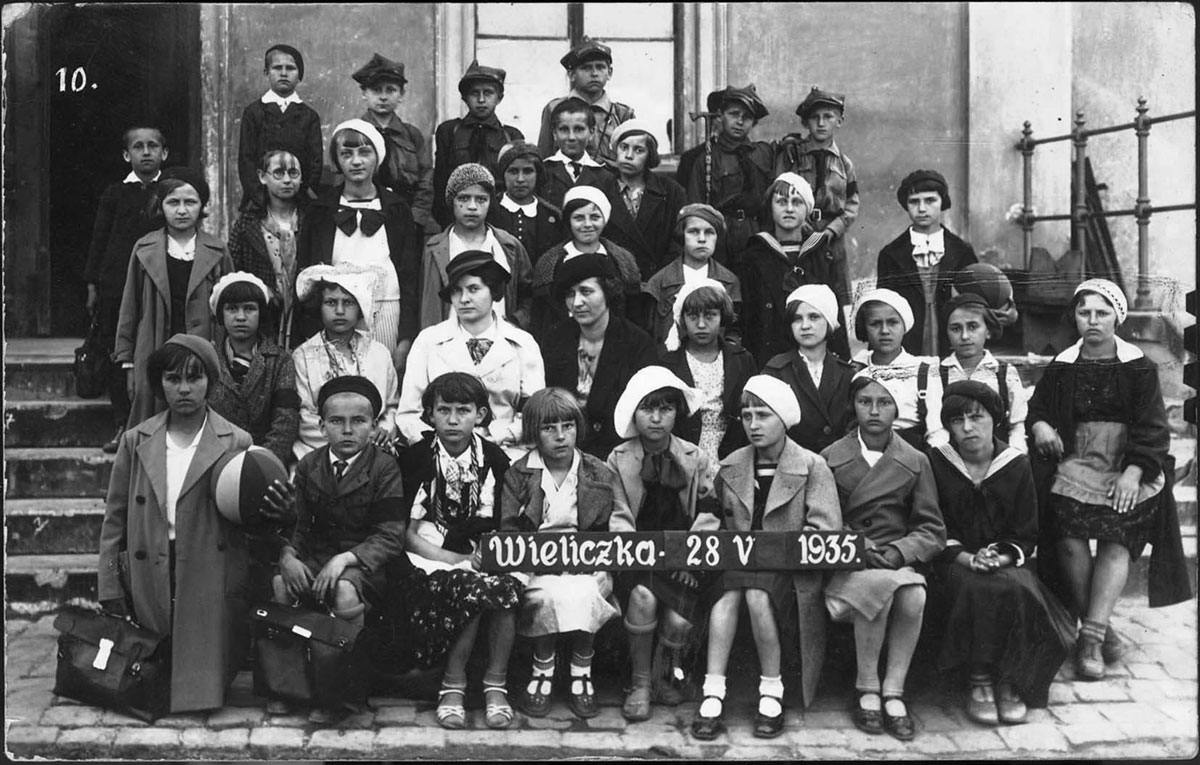The History of Trzebinia before the Holocaust
Jews first settled in Trzebinia (Poland) at the end of the 17th century. Towards the end of the 18th century, about a dozen Jewish families were living in the town, under the auspices of the Jewish community in Olkusz.

Trzebinia (Poland), the market square, 1938-1939
By the beginning of the 19th century, the Jewish community of Trzebinia was subordinate to the community of Chrzanów. In the second half of the 19th century, with the development of mines and industry in the area, the Jewish community began to grow until the whole town was almost entirely Jewish. Until 1914, the town mayor was Jewish. The Jews of Trzebinia supported themselves mainly through small commerce and crafts, as well as by providing resources to local industries.
Religious Life
In the interwar period, Trzebinia served as the cultural and spiritual center for the entire region. It had four synagogues, a Bikur Cholim society (for helping the sick), a burial society, a charitable society, a women’s association, a cheder (religious primary school), yeshivot (Talmudic academies) and shteiblech (prayer houses).
The Bobover Rebbe, Rabbi Ben Zion bar Shlomo Halberstam, resided in Trzebinia from 1932-1937. In 1923 the “Trzebiner Gaon,” Rabbi Dov-Berish Weidenfeld, was elected town rabbi, where he established the “Kochav Miyaakov” Yeshiva. Among Rabbi Dov-Berish’s disciples was Rabbi Akiva Bar Yehezkiel Gross, who received his rabbinical ordination from Rabbi Weidenfeld and established the “Keter Torah” Yeshiva in the town.
More information about Religious Life in Trzebinia >>>
Youth Movements and Political Parties
The first Zionist circle was established in Trzebinia in 1912. Money was collected to launch a library of 1,500 books, as well as evening classes in Hebrew and Jewish studies. The clubhouse of the “General Zionists,” “Haatid,” was very active in the interwar period. It housed the library, twice-weekly lectures and theatrical shows. Other active Zionist youth groups also operated in Trzebinia, including Hashomer Hatzair, Hechalutz, Beitar and Hanoar Haivri – which later gave rise to Hanoar Hatzioni and Akiva.
It is important to note that since the large majority of the town’s male residents were students in the Kochav Miyaakov Yeshiva, they made up most of the Zionist youth group members and organizers.
More information about Youth Movements and Political Parties in Trzebinia >>>
Economic Life
In 1847, Trzebinia was connected to the Vienna-Kraków railway line, and became part of Galicia. This marked the beginning of the development of the town. As the years passed, a lead-casting factory, coal mine, cement factory, oil refinery and other industries were established in the area.
In the second half of the 19th century, most of the Jews lived in the center of the town, making a living in trade and craft, and as storeowners. The various branches of the service industry were also mostly owned by Jews, making it impossible to hire a wagon-driver on the Sabbath or buy bread on Passover. Local Christians complained to the authorities about the situation, resulting in 11 Jewish wagon-drivers being fined 80 crowns each. In addition, two of the wagon-drivers were forced to hire non-Jews on Sabbath days to operate the wagons. Any baker that refused to bake bread over Passover was also fined.
During the interwar period, and especially in the 1920s, the Jewish community found itself economically stagnant. The Jews of Trzebinia were centered around the market place, and continued to deal in small business, crafts and peddling in the surrounding villages: only one family worked in agriculture. During that time, the “Joint” (Joint Distribution Committee – JDC) helped the community of Trzebinia by renovating the bathhouse and building a clinic for the Bikur Cholim society. The Joint also assisted the local charity association, to which ex-Trzebinia residents living in the United States would donate year after year.
The economic condition of the Jewish community improved slightly with the establishment of the court of the Bobover Rebbe in the town, from 1932-1937. Thousands of his followers streamed to his court, mostly on the Sabbath and festival days. Many of the town’s residents, including those who lived there during those years, made their livelihood through their proximity to the court of the Rebbe.
In 1931, Trzebinia was officially recognized as a city.










